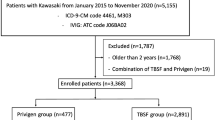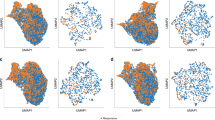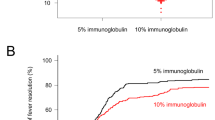Abstract
Background
We aimed to compare the ten different scores (by Kobayashi, Egami, Harada, Formosa, Sano, Piram et al., Wu et al., Yang et al., Tan et al., and Kanai et al.) to assess their performance in predicting IVIG resistance in Turkish children.
Methods
Complete and incomplete KD patients diagnosed with KD at Hacettepe University between June 2007 and September 2019 were evaluated retrospectively.
Results
A total of 129 patients, 79 boys (61.2%), with a median age 36 (IQR 19.5–57.0) months were evaluated. Sixteen patients (12.4%) had IVIG resistance. Sensitivity was low for all the ten scores. Tan, Sano, and Egami predictive models had the highest specificity (97.3, 89.4, 86.7%, respectively). Almost all scoring systems distinguished the group of patients with low risk for IVIG resistance but could not differentiate IVIG-resistant patients. Multivariate analysis for the laboratory features showed that platelet count <300 × 109/L and GGT serum levels were independent risk factors for IVIG resistance (OR: 3.896; 95% CI: 1.054–14.404; p = 0.042 and OR: 1.008; 95% CI: 1.001–1.015; p = 0.050).
Conclusions
The current scoring systems had a low sensitivity for predicting the risk for IVIG resistance in Turkish children. On the other hand, increased serum GGT levels and low platelet count were risk factors for predicting IVIG resistance.
Impact
-
Intravenous immunoglobulin (IVIG) resistance may be observed in 10–20% of patients diagnosed with Kawasaki disease.
-
Coronary artery involvement is more frequent in IVIG-resistant patients.
-
It is important to predict the patients who might develop IVIG resistance to improve prognosis.
-
The performance of the IVIG resistance predictive models in Kawasaki disease in our population is limited due to the low sensitivity.
Similar content being viewed by others
Log in or create a free account to read this content
Gain free access to this article, as well as selected content from this journal and more on nature.com
or
References
Jennette, J. C. et al. 2012 revised International Chapel Hill Consensus Conference nomenclature of vasculitides. Arthritis Rheum. 65, 1–11 (2013).
Singh, S., Vignesh, P. & Burgner, D. The epidemiology of Kawasaki disease: a global update. Arch. Dis. Child. 100, 1084–1088 (2015).
Ozen, S. et al. Childhood vasculitides in Turkey: a nationwide survey. Clin. Rheumatol. 26, 196–200 (2007).
McCrindle, B. W. et al. Diagnosis, treatment, and long-term management of Kawasaki disease: a scientific statement for health professionals from the American Heart Association. Circulation 135, e927–e999 (2017).
Jamieson, N. & Singh-Grewal, D. Kawasaki disease: a clinician’s update. Int. J. Pediatr. 2013, 645391 (2013).
Shulman, S. T. & Rowley, A. H. Kawasaki disease: insights into pathogenesis and approaches to treatment. Nat. Rev. Rheumatol. 11, 475 (2015).
Tremoulet, A. H. et al. Resistance to intravenous immunoglobulin in children with Kawasaki disease. J. Pediatr. 153, 117–121 (2008).
Song, M. S. Predictors and management of intravenous immunoglobulin-resistant Kawasaki disease. Korean J. Pediatr. 62, 119 (2019).
Phuong, L. K., Curtis, N., Gowdie, P., Akikusa, J. & Burgner, D. Treatment options for resistant Kawasaki disease. Pediatr. Drugs 20, 59–80 (2018).
Sano, T. et al. Prediction of non-responsiveness to standard high-dose gammaglobulin therapy in patients with acute Kawasaki disease before starting initial treatment. Eur. J. Pediatr. 166, 131–137 (2007).
Do, Y.-S. et al. Predicting factors for refractory Kawasaki disease. Korean Circ. J. 40, 239–242 (2010).
Davies, S. et al. Predicting IVIG resistance in UK Kawasaki disease. Arch. Dis. Child. 100, 366–368 (2015).
Kobayashi, T. et al. Prediction of intravenous immunoglobulin unresponsiveness in patients with Kawasaki disease. Circulation 113, 2606–2612 (2006).
Harada, K. Intravenous γ‐globulin treatment in Kawasaki disease. Pediatr. Int. 33, 805–810 (1991).
Egami, K. et al. Prediction of resistance to intravenous immunoglobulin treatment in patients with Kawasaki disease. J. Pediatr. 149, 237–240 (2006).
Kanai, T. et al. The combination of the neutrophil-to-lymphocyte and platelet-to lymphocyte ratios as a novel predictor of intravenous immunoglobulin resistance in patients with Kawasaki disease: a multicenter study. Heart Vessels 35, 1463–1472 (2020).
Lin, M.-T. et al. Risk factors and derived formosa score for intravenous immunoglobulin unresponsiveness in Taiwanese children with Kawasaki disease. J. Formos. Med. Assoc. 115, 350–355 (2016).
Wu, S. et al. Prediction of intravenous immunoglobulin resistance in Kawasaki disease in children. World J. Pediatr. 16, 607–613 (2020).
Yang, S., Song, R., Zhang, J., Li, X. & Li, C. Predictive tool for intravenous immunoglobulin resistance of Kawasaki disease in Beijing. Arch. Dis. Child. 104, 262–267 (2019).
Tan, X.-H. et al. A new model for predicting intravenous immunoglobin-resistant Kawasaki disease in Chongqing: a retrospective study on 5277 patients. Sci. Rep. 9, 1–9 (2019).
Piram, M. et al. Defining the risk of first intravenous immunoglobulin unresponsiveness in non-Asian patients with Kawasaki disease. Sci. Rep. 10, 1–10 (2020).
Bozlu, G., Karpuz, D., Hallioglu, O., Unal, S. & Kuyucu, N. Relationship between mean platelet volume-to-lymphocyte ratio and coronary artery abnormalities in Kawasaki disease. Cardiol. Young 28, 832–836 (2018).
Moffett, B. S., Syblik, D., Denfield, S., Altman, C. & Tejtel-Sexson, K. Epidemiology of immunoglobulin resistant Kawasaki disease: results from a large, national database. Pediatr. Cardiol. 36, 374–378 (2015).
Kim, G. B. et al. Epidemiology and clinical features of Kawasaki disease in South Korea, 2012–2014. Pediatr. Infect. Dis. J. 36, 482–485 (2017).
Jakob, A. et al. Kawasaki disease in Germany. Pediatr. Infect. Dis. J. 35, 129–134 (2016).
Sleeper, L. A. et al. Evaluation of Kawasaki disease risk-scoring systems for intravenous immunoglobulin resistance. J. Pediatr. 158, 831.e3–835.e3 (2011).
Kuo, H.-C., Yang, K. D., Chang, W.-C., Ger, L.-P. & Hsieh, K.-S. Kawasaki disease: an update on diagnosis and treatment. Pediatr. Neonatol. 53, 4–11 (2012).
Li, X. et al. Predictors of intravenous immunoglobulin-resistant Kawasaki disease in children: a meta-analysis of 4442 cases. Eur. J. Pediatr. 177, 1279–1292 (2018).
Wang, Y. et al. Unique molecular patterns uncovered in Kawasaki disease patients with elevated serum gamma glutamyl transferase levels: implications for intravenous immunoglobulin responsiveness. PLoS ONE 11, e0167434 (2016).
Aydin, E. A. et al. The factors affecting the disease course in Kawasaki disease. Rheumatol. Int. 39, 1343–1349 (2019).
Chantasiriwan, N., Silvilairat, S., Makonkawkeyoon, K., Pongprot, Y. & Sittiwangkul, R. Predictors of intravenous immunoglobulin resistance and coronary artery aneurysm in patients with Kawasaki disease. Paediatr. Int. Child Health 38, 209–212 (2018).
Kim, M. K., Song, M. S. & Kim, G. B. Factors predicting resistance to intravenous immunoglobulin treatment and coronary artery lesion in patients with Kawasaki disease: analysis of the Korean nationwide multicenter survey from 2012 to 2014. Korean Circ. J. 48, 71–79 (2018).
Ghelani, S. J., Kwatra, N. S. & Spurney, C. F. Can coronary artery involvement in Kawasaki disease be predicted? Diagnostics 3, 232–243 (2013).
Ogata, S. et al. Coronary artery outcomes among children with Kawasaki disease in the United States and Japan. Int. J. Cardiol. 168, 3825–3828 (2013).
Ozdemir, H. et al. Clinical and epidemiological characteristics of children with Kawasaki disease in Turkey. J. Trop. Pediatr. 56, 260–262 (2010).
Yılmazer, M. M. et al. Kawasaki disease in Turkish children: a single center experience with emphasis on intravenous immunoglobulin resistance and giant coronary aneurysms. Turk. J. Pediatr. 61, 648–656 (2019).
Yan, F., Pan, B., Sun, H., Tian, J. & Li, M. Risk factors of coronary artery abnormality in children with Kawasaki disease: a systematic review and meta-analysis. Front. Pediatr. 7, 374 (2019).
Sudo, D. et al. Case–control study of giant coronary aneurysms due to Kawasaki disease: the 19th nationwide survey. Pediatr. Int. 52, 790–794 (2010).
Belay, E. D. et al. Kawasaki syndrome and risk factors for coronary artery abnormalities: United States, 1994–2003. Pediatr. Infect. Dis. J. 25, 245–249 (2006).
Zhang, T. et al. Factors related to cardiac sequelae of Kawasaki disease. Eur. J. Pediatr. 158, 694–697 (1999).
Author information
Authors and Affiliations
Contributions
U.K.A., E.A.A., O.S., E.S., S.D., E.A., and M.K. conceptualized and designed the study, drafted the initial manuscript, reviewed and revised the manuscript. H.H.A. conceptualized and designed the study, drafted the initial manuscript, and critically reviewed the manuscript for important intellectual content. E.D.B. and T.K. conceptualized and designed the study, coordinated and supervised data collection, and critically reviewed the manuscript for important intellectual content. Y.B. and S.O. conceptualized and designed the study, coordinated and supervised data collection, and critically reviewed and revised the manuscript. All authors approved the final manuscript as submitted and agree to be accountable for all aspects of the work.
Corresponding author
Ethics declarations
Competing interests
The authors declare no competing interests.
Ethics approval
This study has been approved by Hacettepe University Ethics Commission (Approval number: GO 20/568). Due to the retrospective nature of the study, informed consent was not required.
Additional information
Publisher’s note Springer Nature remains neutral with regard to jurisdictional claims in published maps and institutional affiliations.
Rights and permissions
About this article
Cite this article
Kaya Akca, U., Arslanoglu Aydin, E., Aykan, H.H. et al. Comparison of IVIG resistance predictive models in Kawasaki disease. Pediatr Res 91, 621–626 (2022). https://doi.org/10.1038/s41390-021-01459-w
Received:
Revised:
Accepted:
Published:
Issue date:
DOI: https://doi.org/10.1038/s41390-021-01459-w
This article is cited by
-
Interpretable web-based machine learning model for predicting intravenous immunoglobulin resistance in Kawasaki disease
Italian Journal of Pediatrics (2025)
-
The clinical value of dynamic monitoring of complete blood count in predicting immunoglobulin resistance in Chinese children with Kawasaki disease
Scientific Reports (2025)
-
C-reactive protein to albumin ratio as a prognostic tool for predicting intravenous immunoglobulin resistance in children with kawasaki disease: a systematic review of cohort studies
Pediatric Rheumatology (2024)
-
Intravenous immunoglobulin resistance in Kawasaki disease patients: prediction using clinical data
Pediatric Research (2024)
-
Risk scores for Kawasaki disease, a management tool developed by the KAWA-RACE cohort
Clinical Rheumatology (2022)



